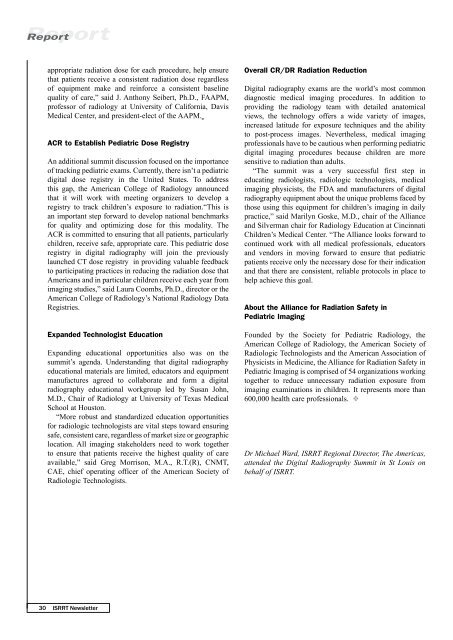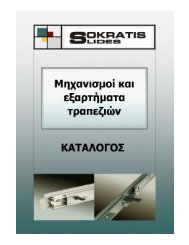isrrt Newsletter Volume 46. No.1 - 2010
Create successful ePaper yourself
Turn your PDF publications into a flip-book with our unique Google optimized e-Paper software.
Report<br />
appropriate radiation dose for each procedure, help ensure<br />
that patients receive a consistent radiation dose regardless<br />
of equipment make and reinforce a consistent baseline<br />
quality of care,” said J. Anthony Seibert, Ph.D., FAAPM,<br />
professor of radiology at University of California, Davis<br />
Medical Center, and president-elect of the AAPM.<br />
ACR to Establish Pediatric Dose Registry<br />
An additional summit discussion focused on the importance<br />
of tracking pediatric exams. Currently, there isn’t a pediatric<br />
digital dose registry in the United States. To address<br />
this gap, the American College of Radiology announced<br />
that it will work with meeting organizers to develop a<br />
registry to track children’s exposure to radiation.“This is<br />
an important step forward to develop national benchmarks<br />
for quality and optimizing dose for this modality. The<br />
ACR is committed to ensuring that all patients, particularly<br />
children, receive safe, appropriate care. This pediatric dose<br />
registry in digital radiography will join the previously<br />
launched CT dose registry in providing valuable feedback<br />
to participating practices in reducing the radiation dose that<br />
Americans and in particular children receive each year from<br />
imaging studies,” said Laura Coombs, Ph.D., director or the<br />
American College of Radiology’s National Radiology Data<br />
Registries.<br />
Expanded Technologist Education<br />
Expanding educational opportunities also was on the<br />
summit’s agenda. Understanding that digital radiography<br />
educational materials are limited, educators and equipment<br />
manufactures agreed to collaborate and form a digital<br />
radiography educational workgroup led by Susan John,<br />
M.D., Chair of Radiology at University of Texas Medical<br />
School at Houston.<br />
“More robust and standardized education opportunities<br />
for radiologic technologists are vital steps toward ensuring<br />
safe, consistent care, regardless of market size or geographic<br />
location. All imaging stakeholders need to work together<br />
to ensure that patients receive the highest quality of care<br />
available,” said Greg Morrison, M.A., R.T.(R), CNMT,<br />
CAE, chief operating officer of the American Society of<br />
Radiologic Technologists.<br />
Overall CR/DR Radiation Reduction<br />
Digital radiography exams are the world’s most common<br />
diagnostic medical imaging procedures. In addition to<br />
providing the radiology team with detailed anatomical<br />
views, the technology offers a wide variety of images,<br />
increased latitude for exposure techniques and the ability<br />
to post-process images. Nevertheless, medical imaging<br />
professionals have to be cautious when performing pediatric<br />
digital imaging procedures because children are more<br />
sensitive to radiation than adults.<br />
“The summit was a very successful first step in<br />
educating radiologists, radiologic technologists, medical<br />
imaging physicists, the FDA and manufacturers of digital<br />
radiography equipment about the unique problems faced by<br />
those using this equipment for children’s imaging in daily<br />
practice,” said Marilyn Goske, M.D., chair of the Alliance<br />
and Silverman chair for Radiology Education at Cincinnati<br />
Children’s Medical Center. “The Alliance looks forward to<br />
continued work with all medical professionals, educators<br />
and vendors in moving forward to ensure that pediatric<br />
patients receive only the necessary dose for their indication<br />
and that there are consistent, reliable protocols in place to<br />
help achieve this goal.<br />
About the Alliance for Radiation Safety in<br />
Pediatric Imaging<br />
Founded by the Society for Pediatric Radiology, the<br />
American College of Radiology, the American Society of<br />
Radiologic Technologists and the American Association of<br />
Physicists in Medicine, the Alliance for Radiation Safety in<br />
Pediatric Imaging is comprised of 54 organizations working<br />
together to reduce unnecessary radiation exposure from<br />
imaging examinations in children. It represents more than<br />
600,000 health care professionals. v<br />
Dr Michael Ward, ISRRT Regional Director, The Americas,<br />
attended the Digital Radiography Summit in St Louis on<br />
behalf of ISRRT.<br />
30 ISRRT <strong>Newsletter</strong>

















